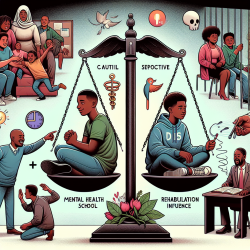Understanding the Risk and Protective Factors for Suicidal Thoughts Among Black Adolescents
In recent years, there has been a troubling rise in suicidal thoughts and behaviors (STBs) among Black adolescents, particularly those with histories of arrest. A recent study titled Individual and Contextual Risk and Protective Factors for Suicidal Thoughts and Behaviors among Black Adolescents with Arrest Histories sheds light on the various risk and protective factors that influence these outcomes.
Key Findings from the Study
The study, which analyzed data from 513 Black youth aged 12-17 with arrest histories, found that:
- 9.78% of participants endorsed suicidal ideation.
- 7.17% reported a previous suicide attempt.
- Gender (female) and depression severity were identified as significant risk factors for STBs.
- Positive parenting and religiosity emerged as protective factors against STBs.
- School engagement was associated with lower levels of suicidal ideation.
Implications for Practitioners
For practitioners working with Black adolescents, especially those involved with the youth punishment system, these findings highlight the importance of focusing on both risk and protective factors. Here are some actionable insights:
- Enhance Positive Parenting: Encourage and support parents to engage in positive parenting practices. This can include providing resources and training to help parents build strong, supportive relationships with their children.
- Promote School Engagement: Work with schools to create environments that foster engagement and connection for Black youth. This can involve developing programs that address the unique challenges faced by students with arrest histories.
- Incorporate Religiosity: Recognize the role of religiosity as a protective factor. Encourage youth to engage in religious or spiritual activities that provide a sense of community and support.
- Address Depression Early: Implement early screening and intervention strategies to identify and treat depression among Black adolescents. This can help reduce the risk of STBs.
Encouraging Further Research
While this study provides valuable insights, there is a need for further research to explore additional contextual risk factors, such as adverse childhood experiences (ACEs) and racial trauma. Future studies should also consider mixed methods approaches to gain a deeper understanding of the lived experiences of Black adolescents.
Practitioners are encouraged to stay informed about the latest research and incorporate evidence-based strategies into their practice to effectively support Black adolescents at risk of STBs.
To read the original research paper, please follow this link: Individual and Contextual Risk and Protective Factors for Suicidal Thoughts and Behaviors among Black Adolescents with Arrest Histories.










